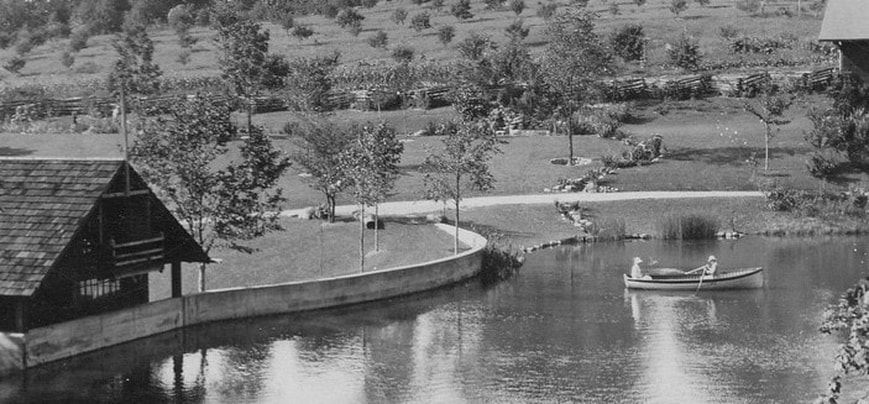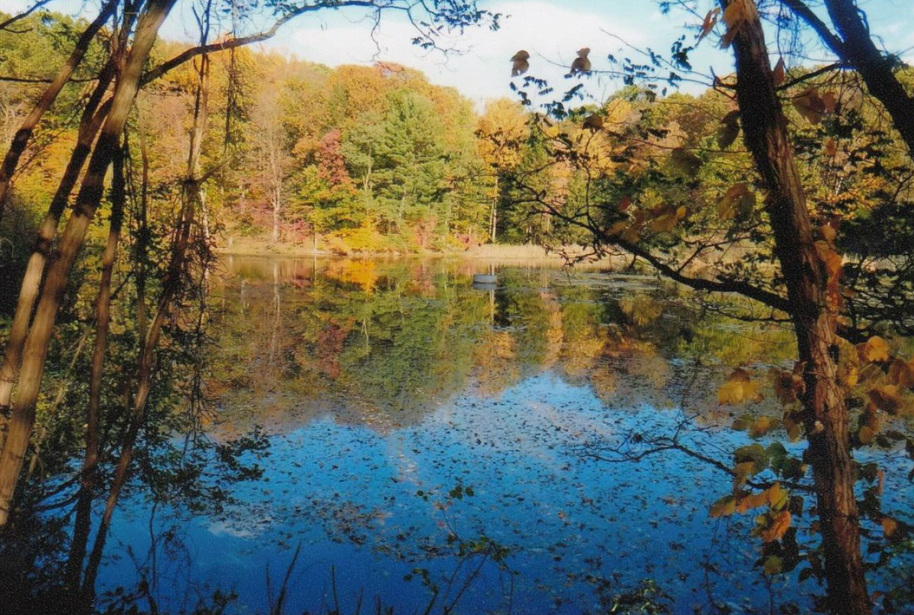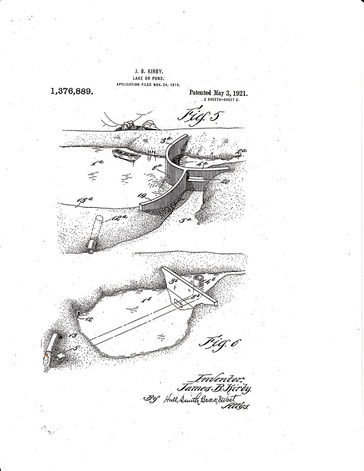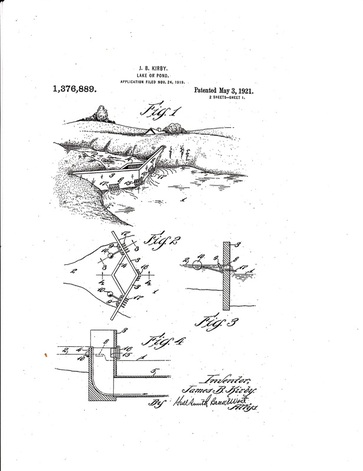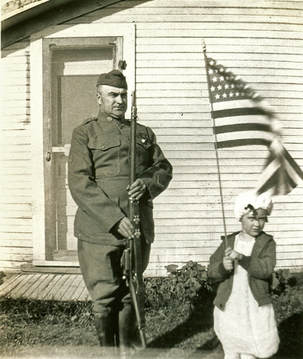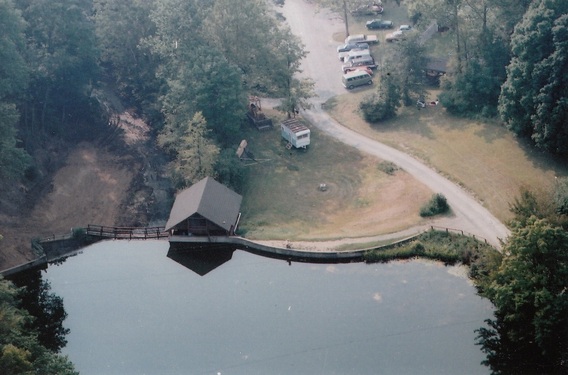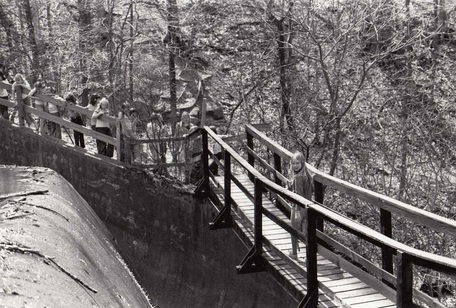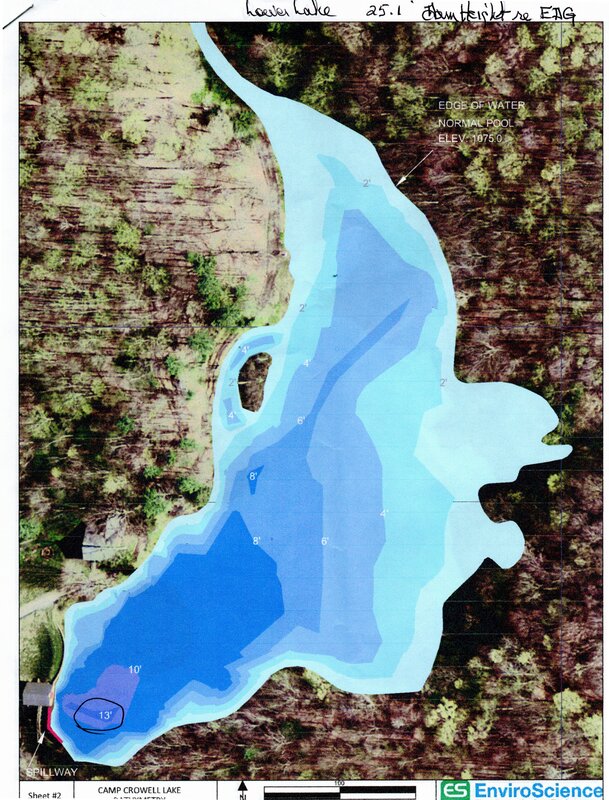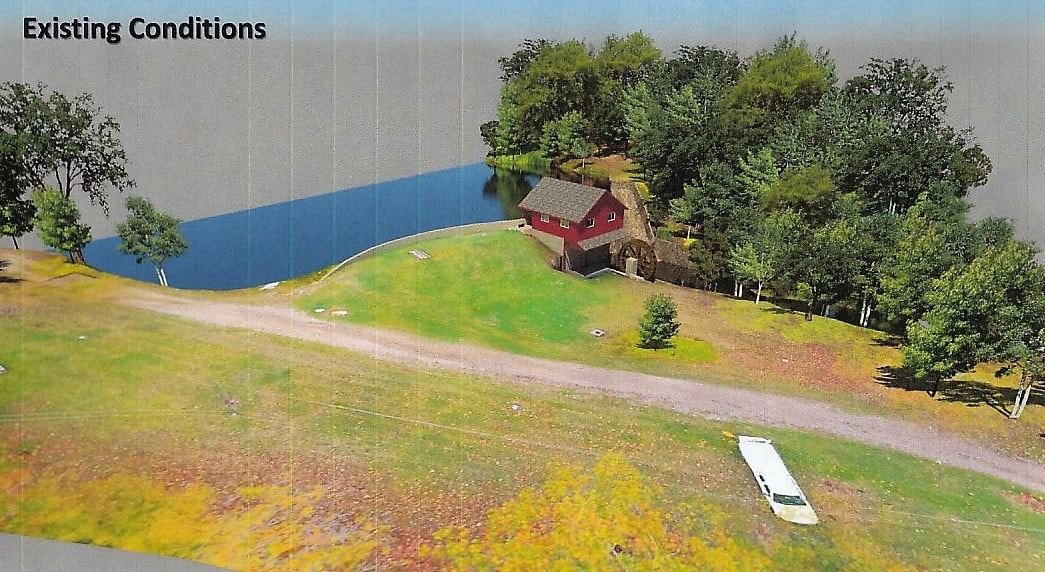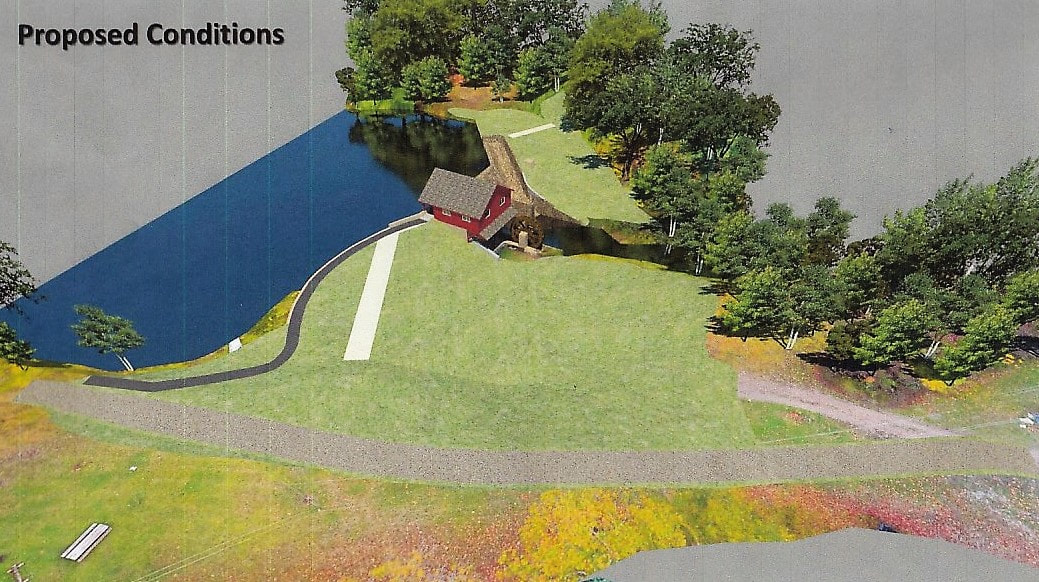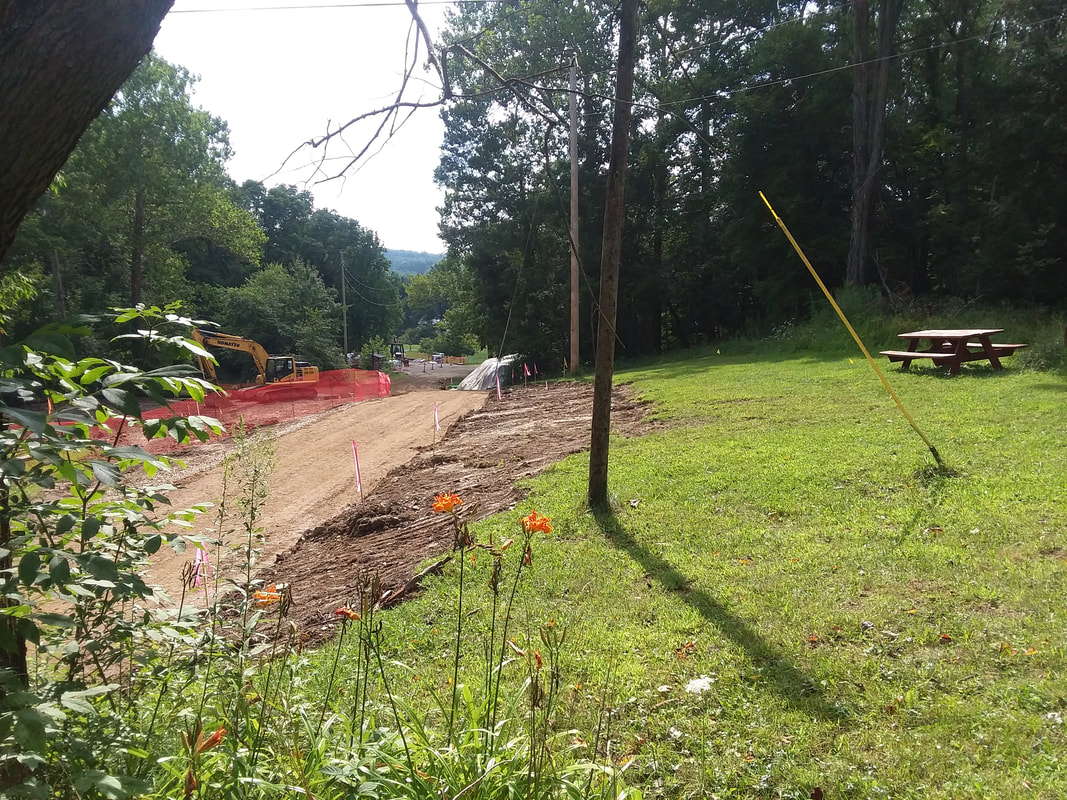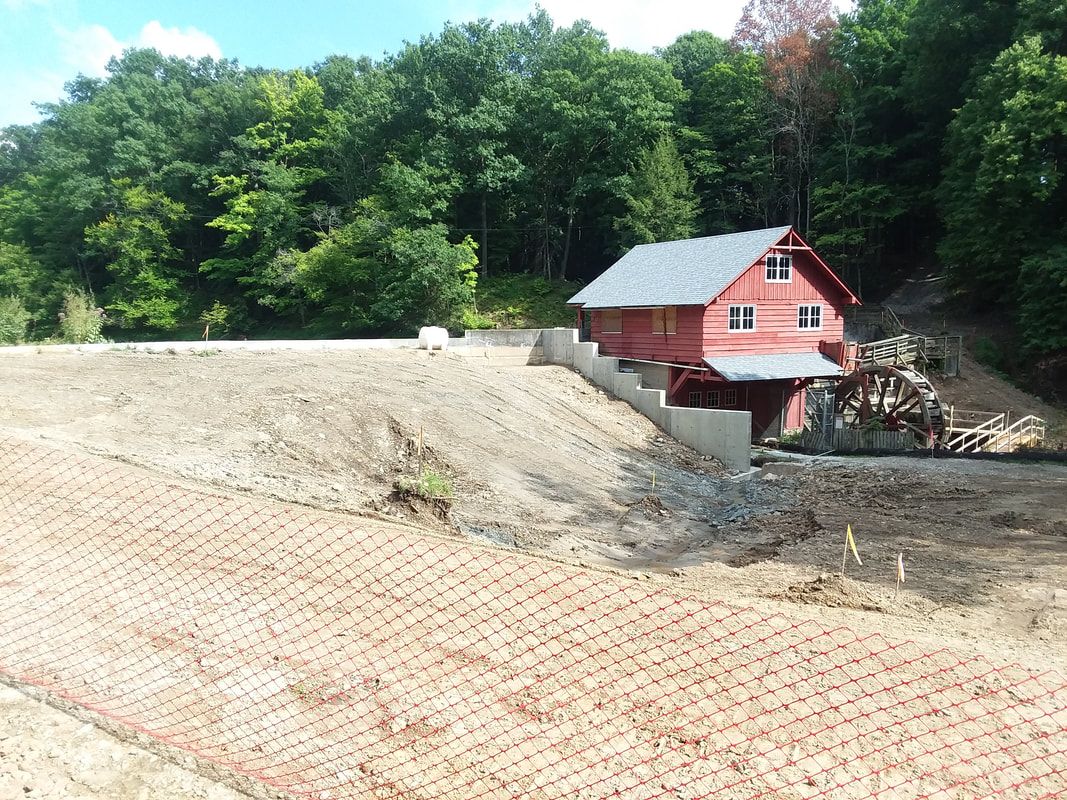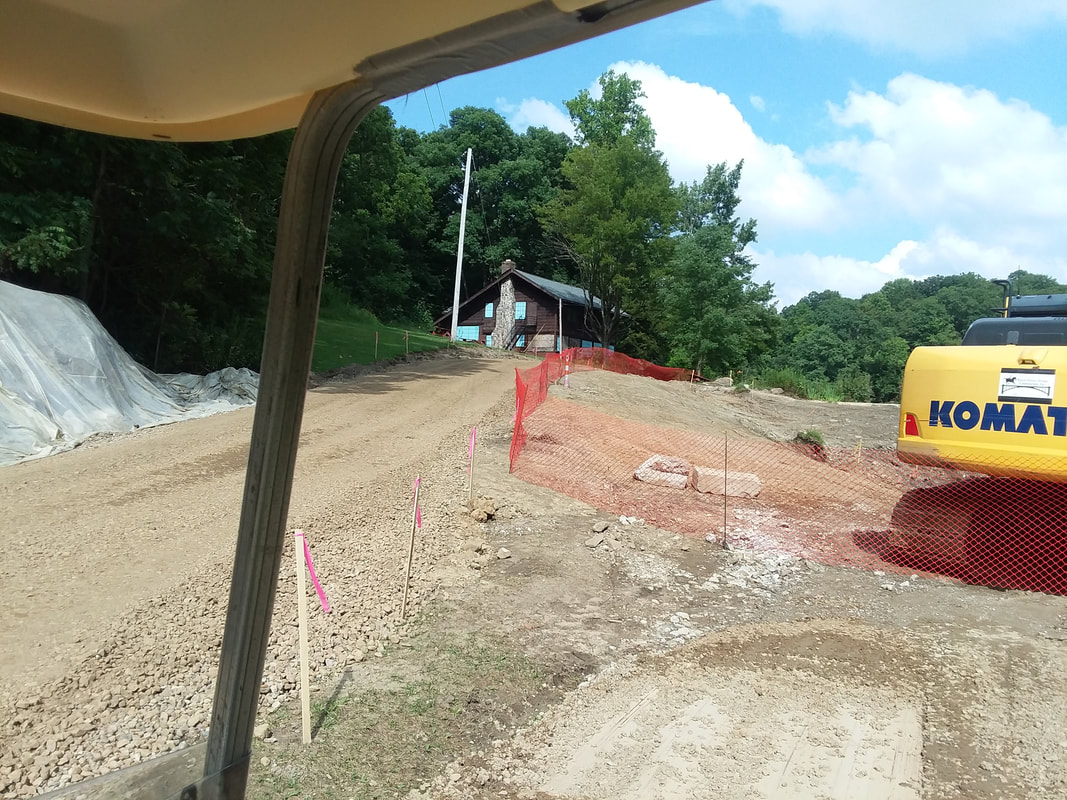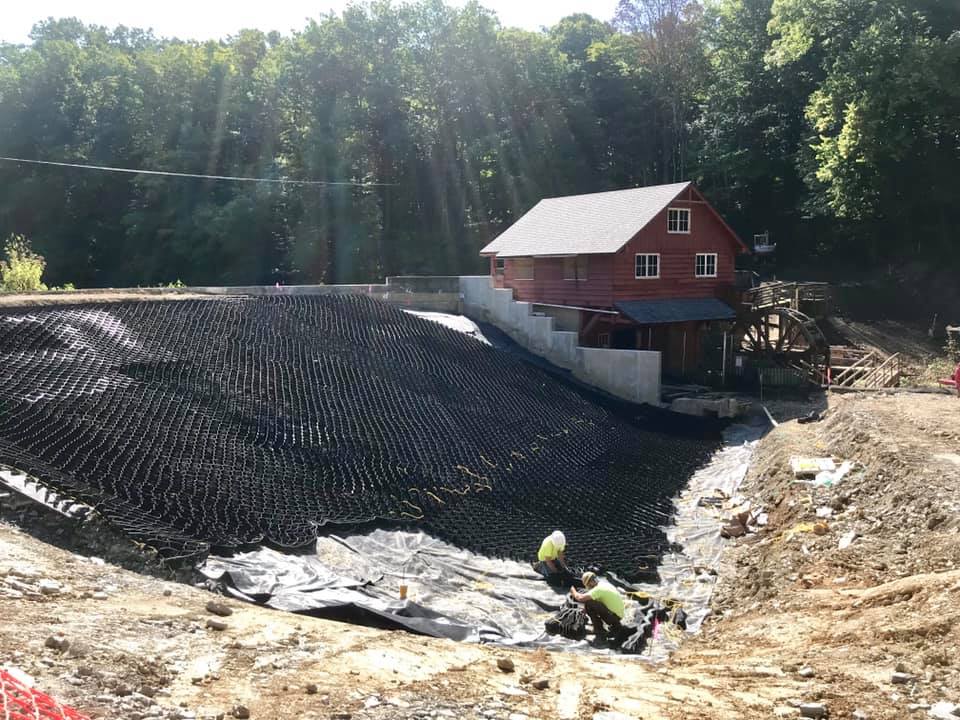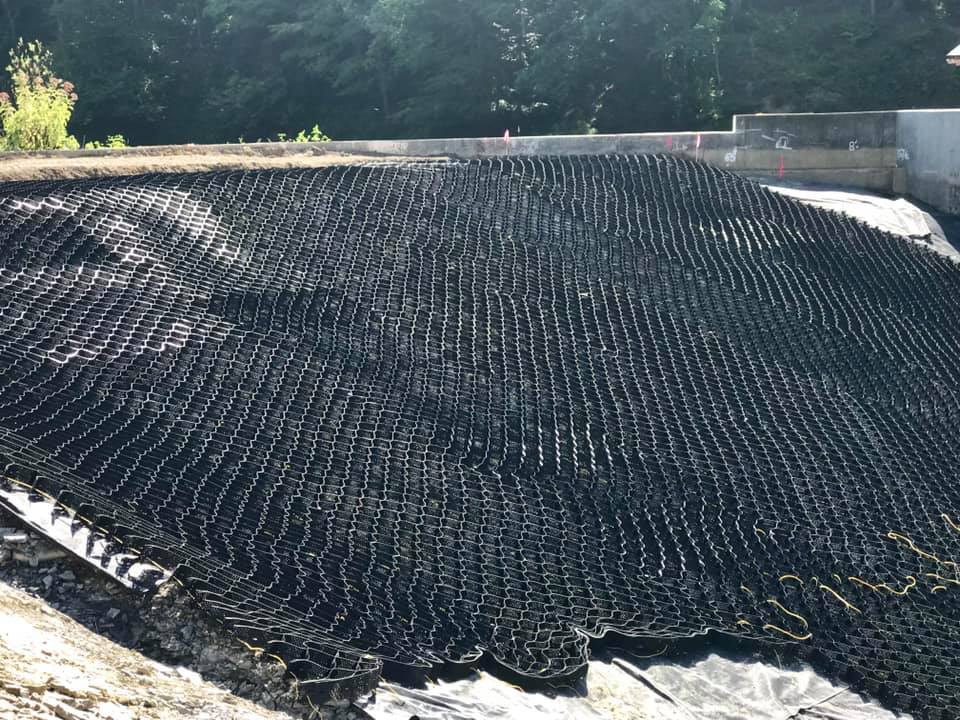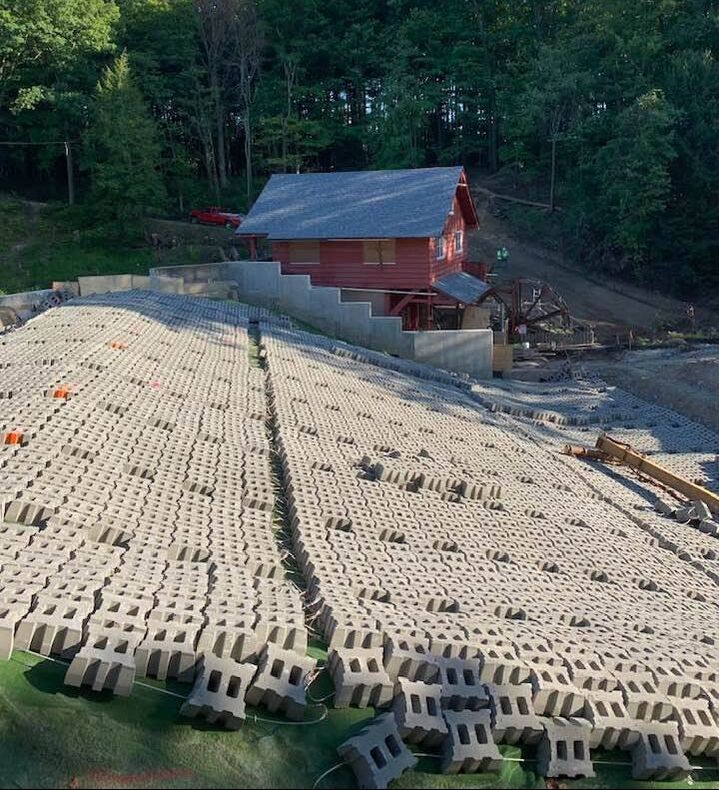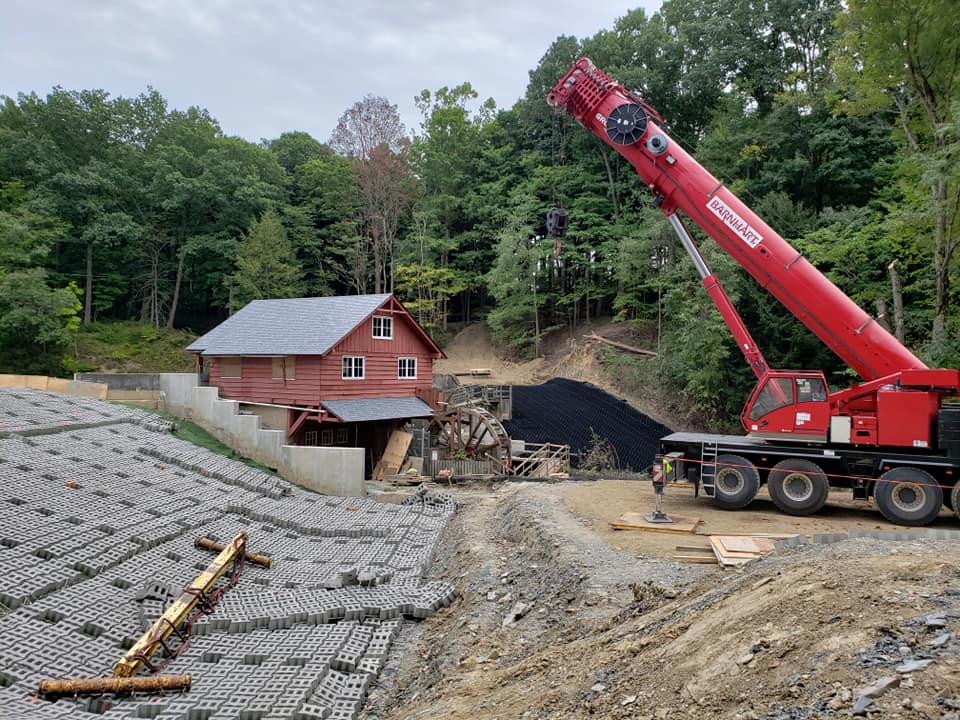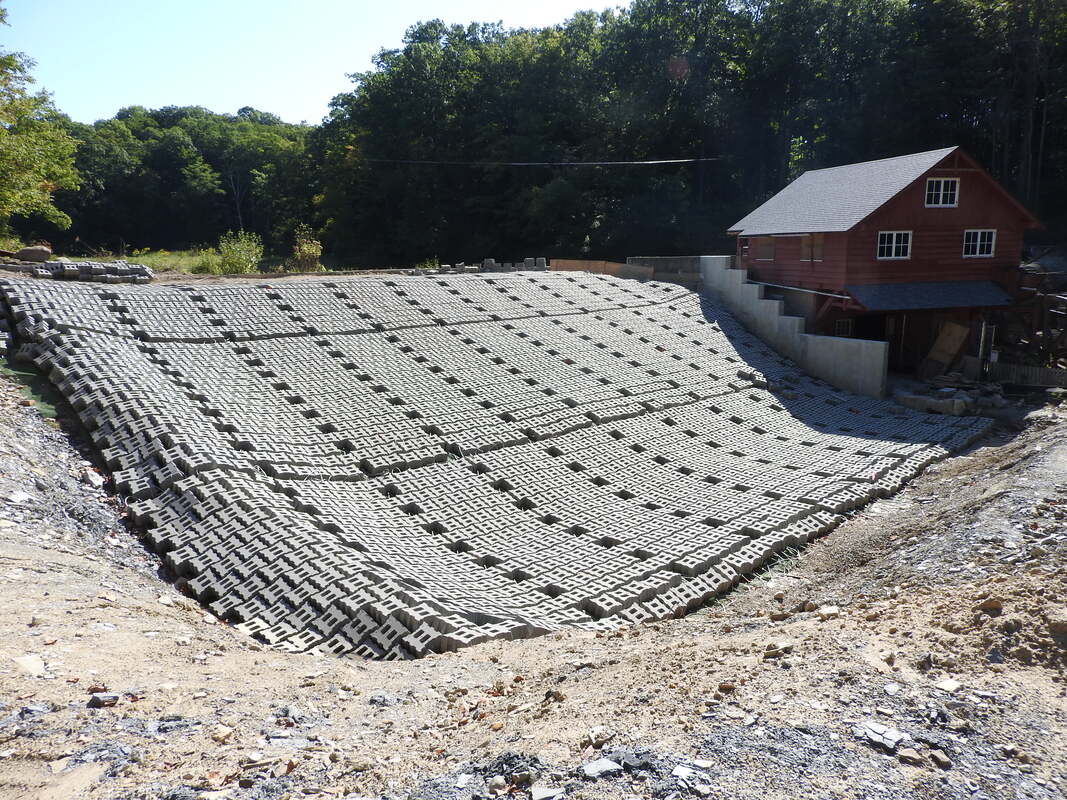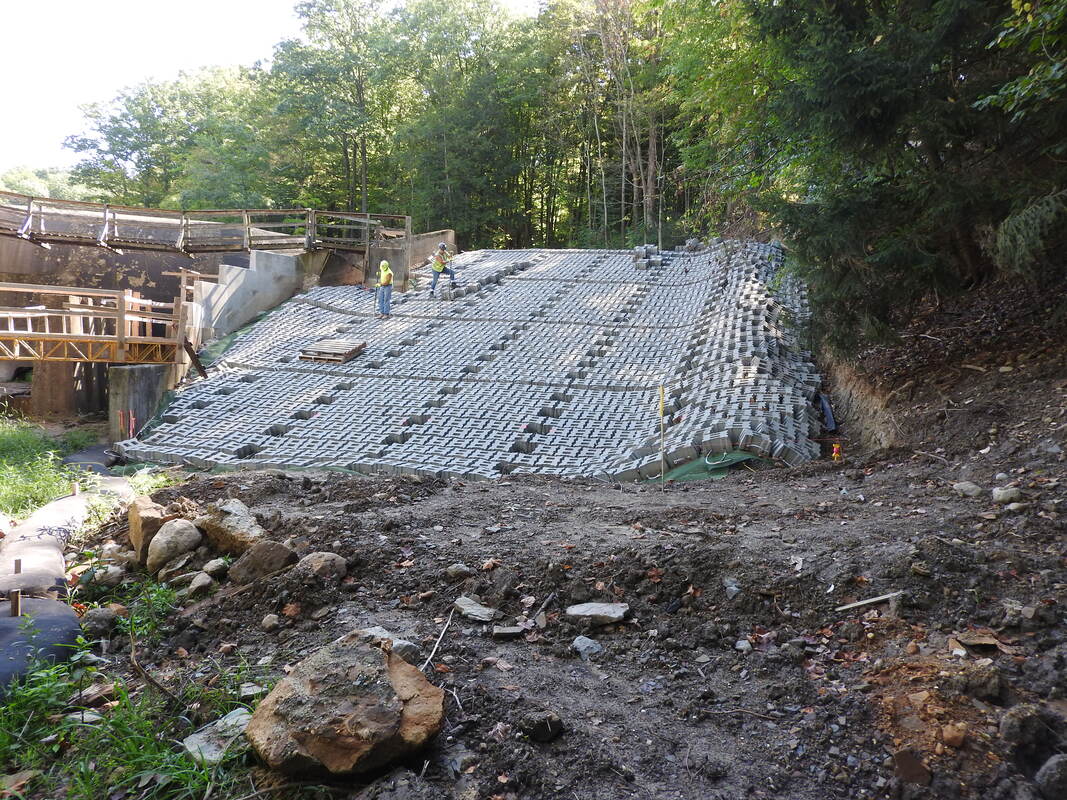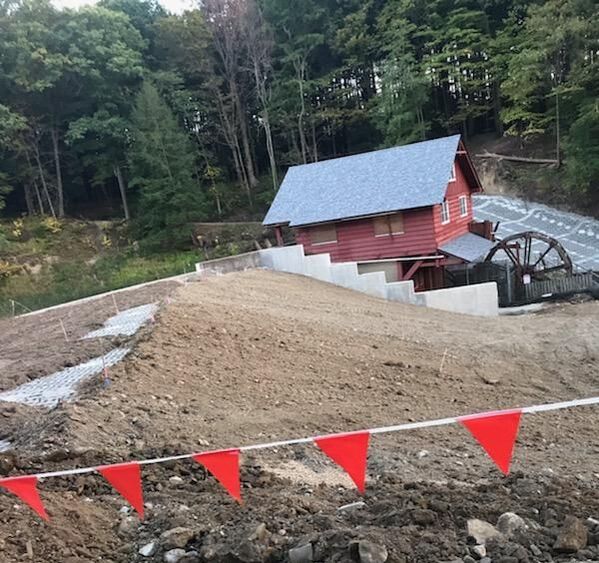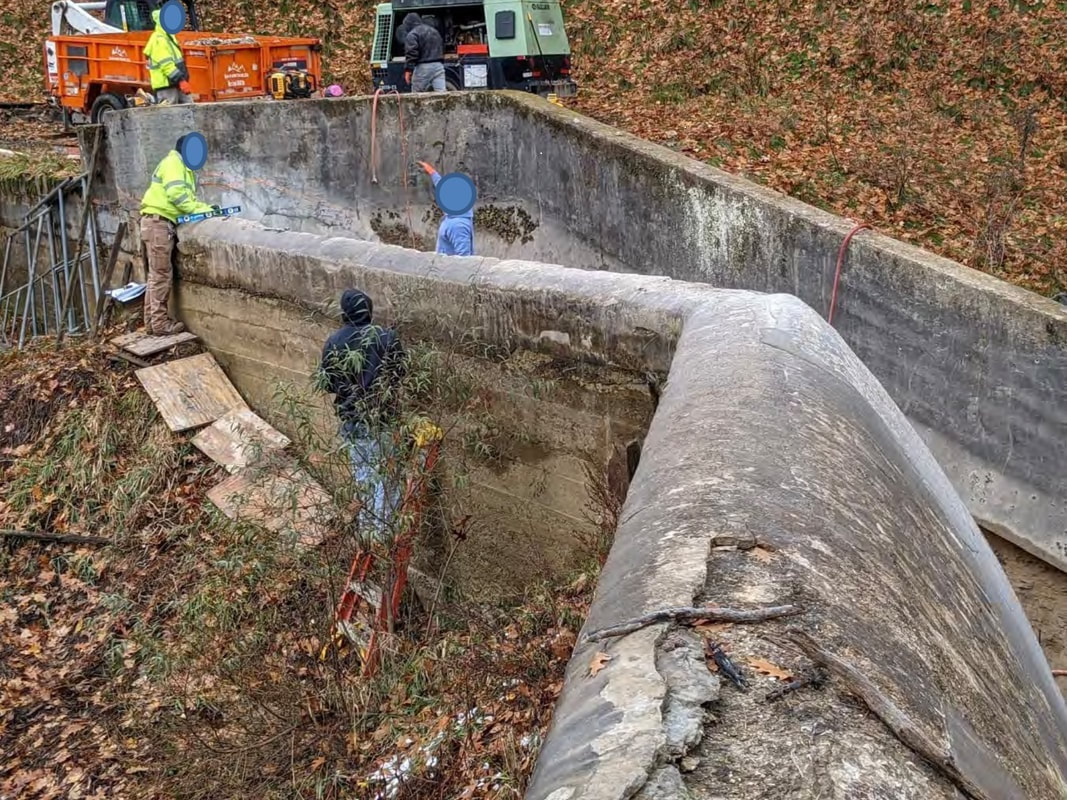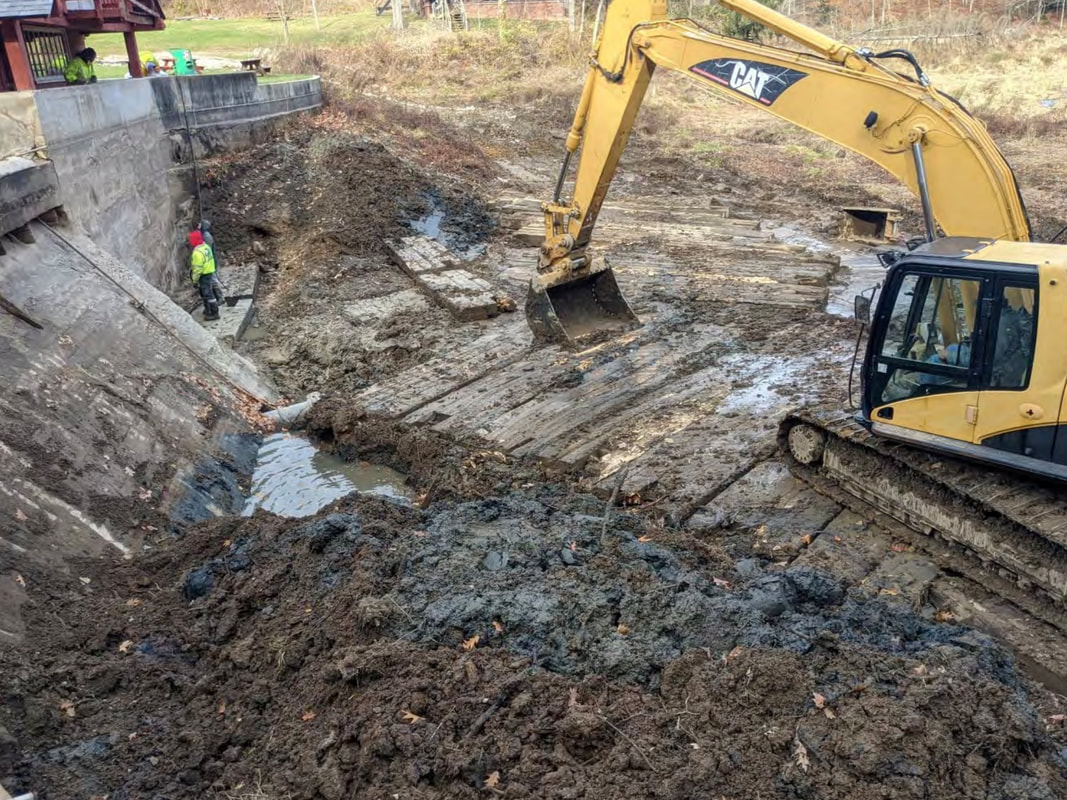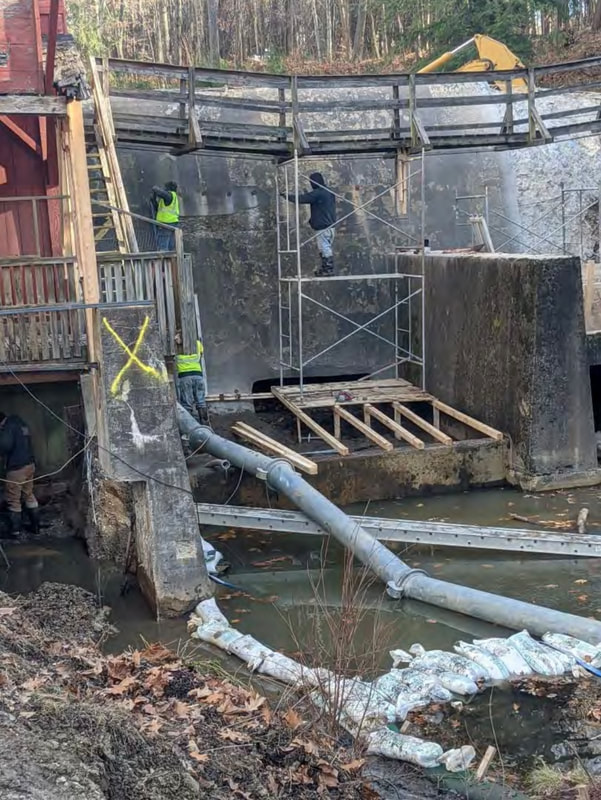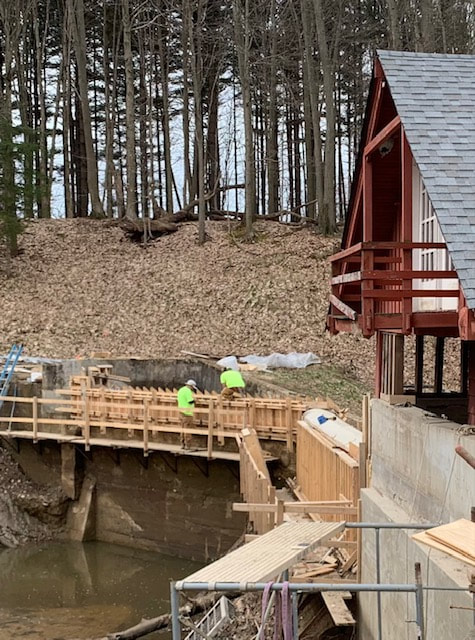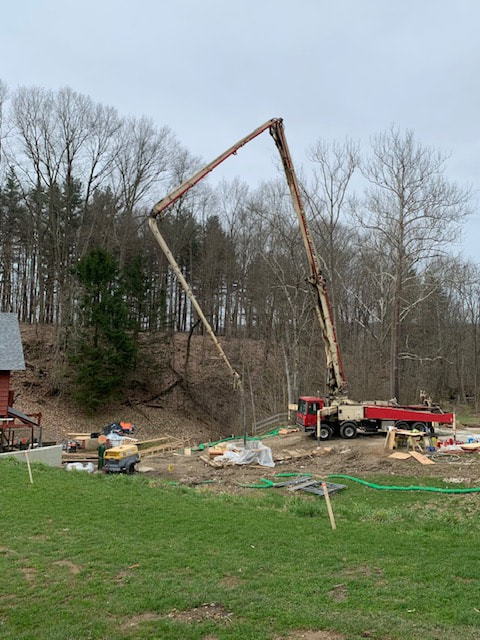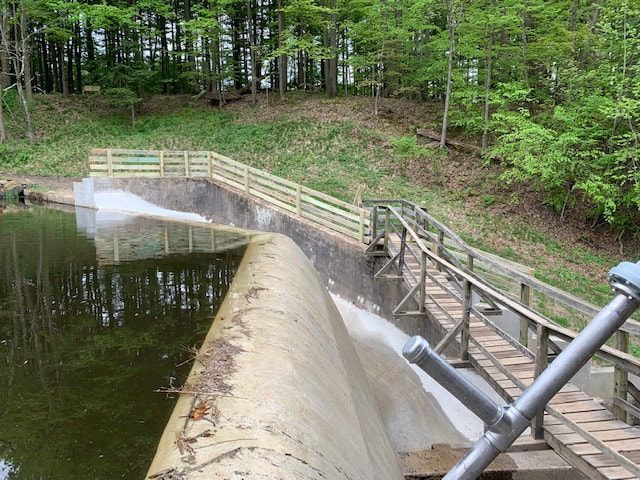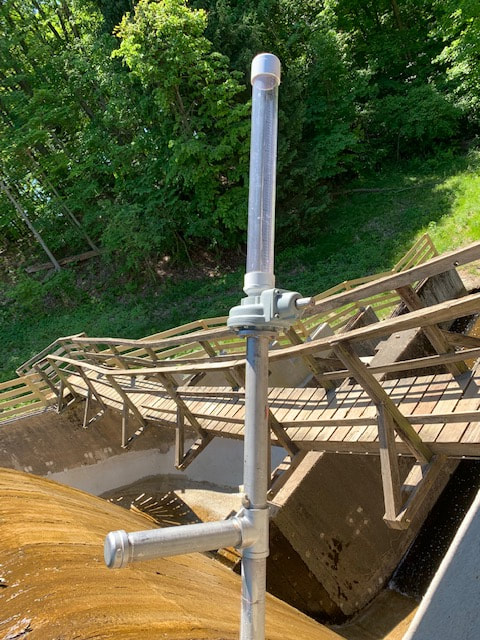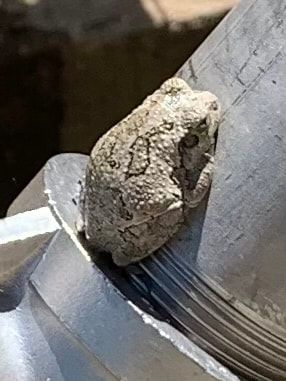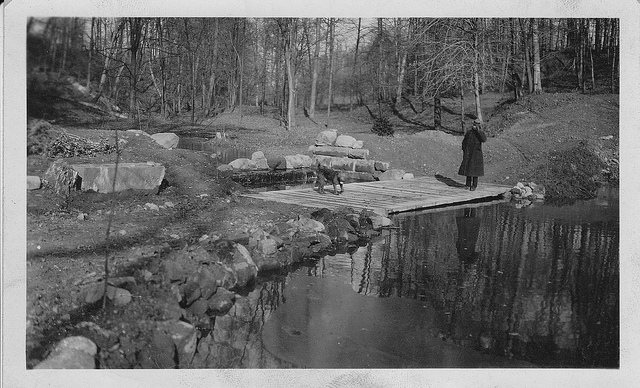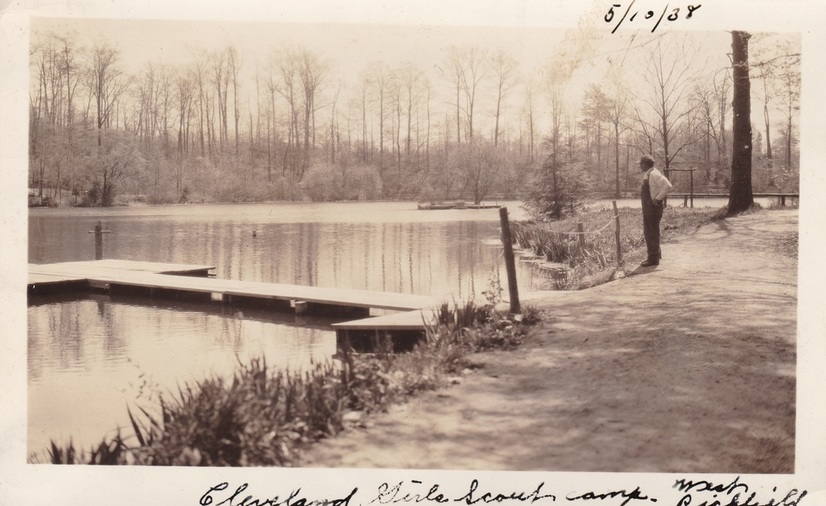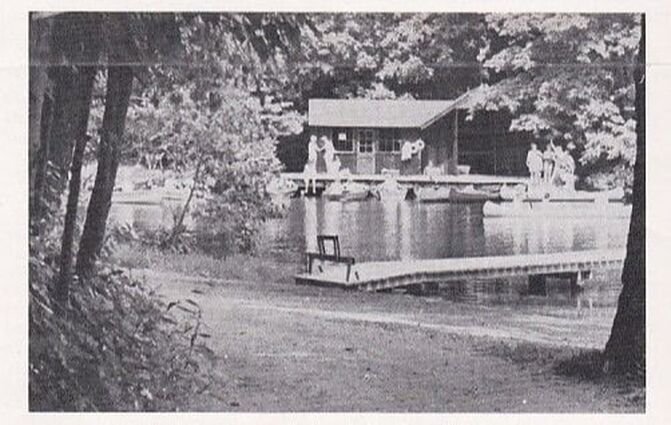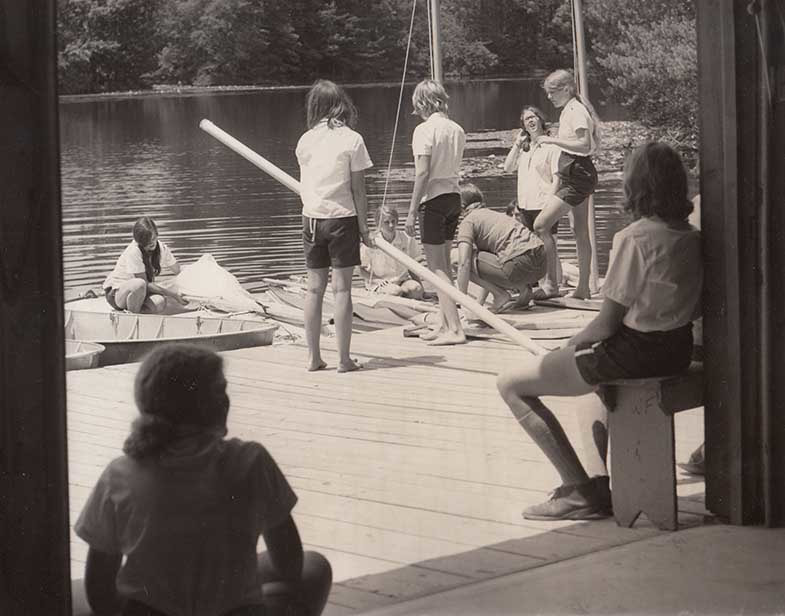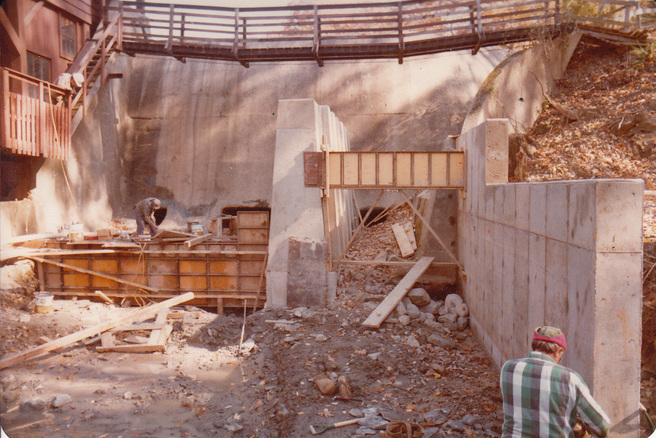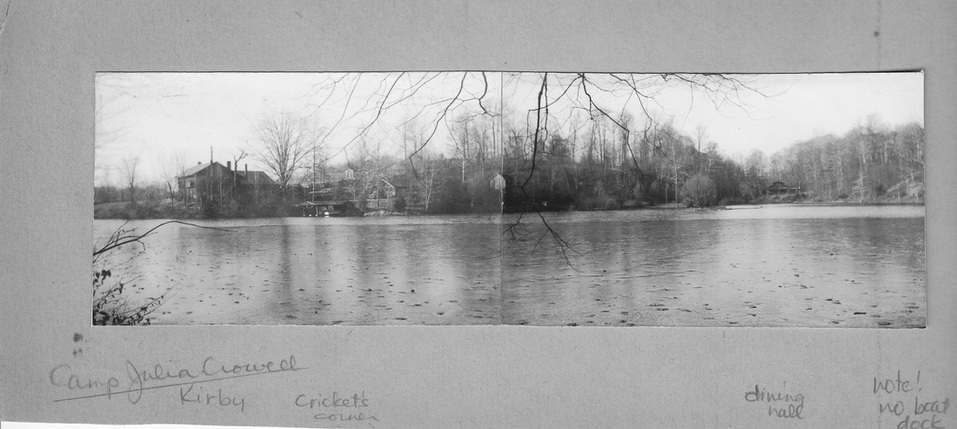Lake Jinelle
In naming what may have been the world’s first patented lake, Kirby combined the name of his wife, “Nellie” with his own name, ”Jim”. The merged waters of the two streams flowing into the new Lake Jinelle would forever represent their love.
Lake Jinelle is the world's only known patented lake
Jim Kirby designed the lake in front of his house to remain clear for fishing, swimming and boating. Silt accumulation was minimized, as was the need for periodic dredging. Kirby patented this idea.
How it worked:
How it worked:
It’s the storm run-off that carries sediment. By diverting storm water away from the lake basin, the water in the lake would stay clear.
Kirby built multi-level gates, or intake dams, across the two incoming creeks. The gates had openings to allow passage of the usual clear water. The openings were equipped with float valves. When the water rose, the valves would shut. The water would then flow into a higher level gate, into a drain that flowed beneath the lake and came out downstream of the main retaining dam. Scroll to the bottom of the page to see the full patent. Kenneth Swan wrote, "Jim Kirby built a large lake on his property next to a large house that he built. .....Underneath the dam in the lake bed he had constructed a pipe to take overflow water under the lake to below the dam. This sewer pipe was large enough to allow a man in a specially constructed sled to travel the length and repair any leaks in the piping. I remember Henry Hammond did this job."
Kirby built multi-level gates, or intake dams, across the two incoming creeks. The gates had openings to allow passage of the usual clear water. The openings were equipped with float valves. When the water rose, the valves would shut. The water would then flow into a higher level gate, into a drain that flowed beneath the lake and came out downstream of the main retaining dam. Scroll to the bottom of the page to see the full patent. Kenneth Swan wrote, "Jim Kirby built a large lake on his property next to a large house that he built. .....Underneath the dam in the lake bed he had constructed a pipe to take overflow water under the lake to below the dam. This sewer pipe was large enough to allow a man in a specially constructed sled to travel the length and repair any leaks in the piping. I remember Henry Hammond did this job."
When Kirby designed his silt-free lake in 1919, flood control regulations were barely thought of. Surprisingly, even the famously tragic Johnstown Flood in 1889 did not immediately inspire reform in dam-building. But with the passage of time and growing understanding of hydrology, even well-constructed dams such as Kirby’s became subject to to new design standards. Chief among the concerns was a dam’s ability to release excess water both quickly and safely. Dams are classified by the amount of water they impound and by their proximity to human activity. Kirby’s dam, with Kirby's Mill smack in the middle of it, was a popular destination in what had become a girls’ camp. lt was given a “Class 1” rating and required to pass 100 % of the “probably maximum flood” without over-topping. Lake Erie Girl Scout Council added an emergency spillway in 1980. It wasn’t enough. They brought in engineers to study the problem, but they were unable to solve it.
Richfield acquired the former camp knowing the dam was a problem. The governing board, RJRD; built funds for dam repair into the 2014 bond issue that purchased the property. After consulting with expert architects, hydrologists, geologists and engineers, they hit upon a brilliant solution offered by engineering firm Gannett Fleming. They would armor the earthen portion of the dam in a cloak of chain mail. Or the geo-sized version of chain mail: Articulated concrete blocks ( ACBs ) that would hold the ground in place if a flood overtopped the wall. In effect, the entire dam would become its own emergency spillway.
It has worked successfully in neighboring states, but it’s never been tried in Ohio. Lake Jinelle will be the first .
Bolstered with her new armor, Lake Jinelle may once again welcome recreational use and provide hydroelectric power as Kirby designed.
Renderings for the dam re-configuration by Gannett Fleming
It was fascinating to watch the changes in the dry lakebed over three summers. The two main streams that feed the lake quickly formed new, meandering channels in the soft mud bottom. During the first summer the mud developed a thin haze of green. In the second year, the lake bed blossomed. By late summer, it had become an amazing, giant bouquet of goldenrod, boneset, Joe Pye weed, tickseed, ironweed, vervain, jewelweed, purple loosestrife, and and swamp rose mallow. in the third summer, the flowers were still there, but they had become dominated by small trees, mostly willows and sycamores. The Saturday volunteer crew cut down many of the willows before work started again on the dam.
Work resumed on the dam in the fall of 2021.
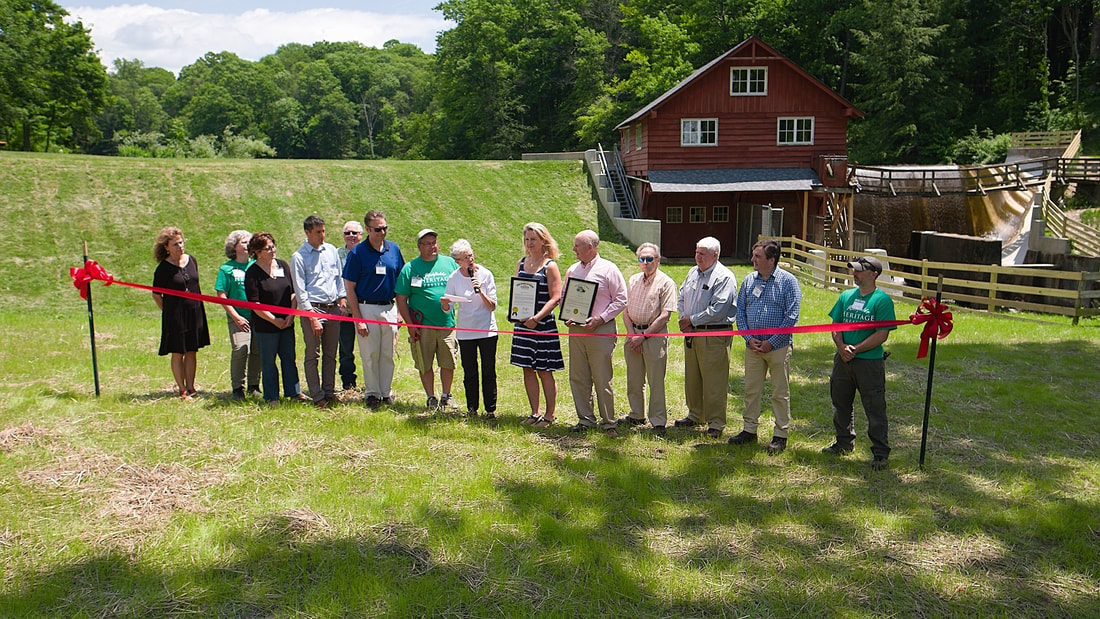
Work on the dam was completed in May 2022. Pictured above, the ribbon cutting ceremony June 12, 2022. IN attendance: Sue Ann Philippbar, Village Council; Polly Wheeler, Admin Coordinator; Sandy Apidone, JRD Board; Mike Selig, JRD Board; Mike Wheeler, Village Mayor; Dave Wehner, JRD Board; Jeff Deluca, JRD Board; Anita Gantner, JRD Board; Kristina Roegner, Ohio State Senator; Bill Roemer, Ohio State Representative; Chuck Boester, Village Council; Pat Norris, Village Council; Mark Robeson, JRD Board; Chris Moore, JRD Maintenance Tech. Photo by Chris Naizer
|
above: top of the primary spillway soon after work on the dam was finished in spring 2022. The water in the lake has not yet reached the top! The valve control stem is shown in the lower right corner of the picture.
right: Close up view of the control valve including the clear cylinder measuring gauge at the top. |
left: There is an irregularity just above the lower joint of the valve stem.
above: upon closer investigation, the irregularity turns out to be a frog whose silver color blends in with the metallic surface of the valve stem. Director of Park Operations Jeff DeLuca identified it as a "Grey Tree Frog" |
Life moves fast.
The first year after the lake had been drained for dam repairs, the dry lake bed appeared to be barren. Water from both main creeks quickly cut meandering channels that joined and flowed to the base of the dam. In the second year, the lake bed bloomed with wildflowers. By late summer it was a veritable bouquet including rose mallow, goldenrod, boneset, and ironweed. in the third summer, tees began to flourish, especially willows and sycamores. Anticipating the return of the water, the trees were cut down that fall.
Before the lake has even filled completely, frogs were moving in. Their calls ringing out over the water. After only one month, bluegills were nesting along the shore.
The first year after the lake had been drained for dam repairs, the dry lake bed appeared to be barren. Water from both main creeks quickly cut meandering channels that joined and flowed to the base of the dam. In the second year, the lake bed bloomed with wildflowers. By late summer it was a veritable bouquet including rose mallow, goldenrod, boneset, and ironweed. in the third summer, tees began to flourish, especially willows and sycamores. Anticipating the return of the water, the trees were cut down that fall.
Before the lake has even filled completely, frogs were moving in. Their calls ringing out over the water. After only one month, bluegills were nesting along the shore.
History
The construction and filling of Kirby’s patented lake was of great interest to the neighbors. The Richfield Reunion souvenir booklets report on Kirby’s progress:
The lake was stocked with a variety of fish. After the house was built and the lake filled, Kirby constructed the mill at on the retaining dam, and slung a swinging bridge across the face of the spillway. Next he built the dance hall at the head of the lake. The following year he began construction of a deeper lake upstream ( to be stocked with larger fish. ) Back on the lower lake, Kirby built a pier, boathouse, and lakeside picnic shelter. From Bigelow family reunion scrapbook: The lake was the center point of many gatherings- including Bigelow Family reunions (1920 & 1927) and the Vacuette Company picnic (1922 & 1923)
- 1918 “Changes and Removals – Raymond Oviatt has sold his farm to James Kirby of Cleveland and has bought GF Garman’s house.”
- 1919 “Improvements – Mr. Kirby is building a dam on the farm he bought of Raymond Oviatt and expects to have seven or eight acres covered with water before winter.”
- 1920 “ Changes and Improvements – James Kirby, who bought the Oviatt Farm and built an artificial lake and Swiss Chalet has given the public use of his grounds and lake every Monday and Friday for recreational purposes. Also by special arrangements picnics and lawn fetes have been held there. This is a most beautiful spot and all Richfield is grateful to Mr. Kirby for his generosity in allowing us to enjoy its beauties with him.”
The lake was stocked with a variety of fish. After the house was built and the lake filled, Kirby constructed the mill at on the retaining dam, and slung a swinging bridge across the face of the spillway. Next he built the dance hall at the head of the lake. The following year he began construction of a deeper lake upstream ( to be stocked with larger fish. ) Back on the lower lake, Kirby built a pier, boathouse, and lakeside picnic shelter. From Bigelow family reunion scrapbook: The lake was the center point of many gatherings- including Bigelow Family reunions (1920 & 1927) and the Vacuette Company picnic (1922 & 1923)
Jim Kirby standing near the intake dam bridge before Garfield Hall was built
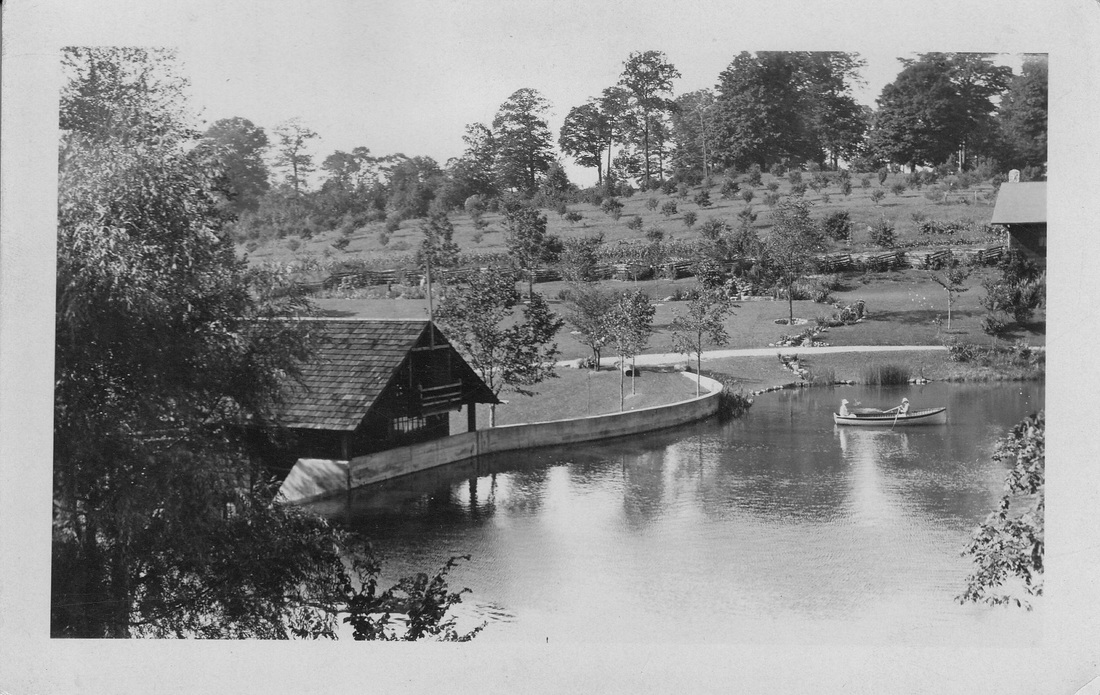
This picture of the lake is undated. But my guess is around 1926. ( The slope in the background was empty when Kirby bought the place in 1919. He probably didn’t plant the orchard until after he finished building his house in 1921. The trees look to be just a few years old here)
You can see that the concrete parapet on top of the dam looked pretty much like it does now. You can also see three trees planted right along side it. They look to be maple or ash by the branch patterns. On the attached snapshot from the 1969 series, the tree closest to the mill is still there, but the middle one had recently been cut down.
There is a little stone-lined creek running under the road and leading down to the lake shore. I think that may have come from the spring that eventually got diverted to the roof-top air conditioner but in this picture the water is directed into a little decorative pond.
Statement of the Richfield Historical Society to the RJRD concerning the Lower Lake - September 2016
The lower lake is the central historical element in that whole property.
It’s the world’s only known patented lake. Kirby’s house, the mill, the boat landing, and the dance hall are all oriented around the lake. Kirby loved it. His bedroom windows and his workshop loft all overlooked the lake. It was a source of inspiration and tranquility for him.
If you remove the lower dam, then you lose the lake. If you lose the lake, you lose the immediacy of Kirby’s story. Kirby’s story is what makes this property unique. Kirby’s home blended technology and nature- a lesson needed for our time
Lose the lake and you lose Kirby’s 20th century spin on the ancient combination of lake, dam, mill, and bridge that existed around the world for over a thousand years. These four elements were all components of an integrated system that was the main source of power generation for over a thousand years.
Lose the lake and the mill won’t ever work. Sure you can “save” it, but what for? It’s got an overshot wheel. That means the water has to come in over the top and it needs a millpond in order to work. Kirby’s wheel design was an innovative experiment. Kirby’s Mill was placed on the National Historic Register in 1978 largely because the wheel was the first of its kind. You can’t convert it to an undershot wheel without losing the essence of what Kirby built. In addition, we are just finding out now how experimental the whole mill design was. It appears as though Kirby re-engineered his original concept for the millhouse structure. That too, is part of the story. What a great thing to demonstrate to children: if your first try fails, then re-design your solution. Kirby’s Mill shows that. But only if it has the power of falling water to drive it.
The repair of the lower dam will cost money. But that’s why the RJRD set the amount of the bond issue higher than just the cost of the land purchase. RJRD still has millions of dollars for capitol repairs on the property– most of which must be spend in the next two years. You have the Friends of Crowell Hilaka to raise awareness, excitement, and needed funds for historic building restoration later on.
RJRD voted to call the place “Richfield Heritage Preserve” was because they wanted to Preserve Richfield Heritage. Keeping the lakes by repairing the dams is a necessary first step.
To: The board of the Richfield Joint Recreation District,
As you begin to make decisions about the dams which form the historic lakes of Richfield Heritage Preserve, we submit the following Amicus brief for your review to assist you in making informed choices.
Historic Significance of the Lower Dam and Lake at
Richfield Heritage Preserve
As a regional destination, Kirby’s estate has enormous potential for STEAM ( Science, Technology, Engineering, Arts, Math ) education. Kirby applied technology to a beautiful natural setting, creating a truly unique place. His structures are rustic, whimsical, and brilliant. Their workings are simple enough and approachable enough that with simple explanations, a child can understand the basic concepts. Kirby’s story and his estate have the ability to inspire the next generation of engineers and scientists in a way that no laboratory could. The Lower Lake is the focal point for the estate, both for its aesthetics and for the innovative hydraulics with which it was constructed.
Other significant historic factors:
· The first permanent settlers on the Preserve were the Oviatts. The Oviatts constructed a dam to create millpond – in roughly the same place as the current dam.
· The Oviatts operated a sawmill. They milled the boards for their house in that sawmill in 1834.
· Nathaniel Oviatt, one of the first Township trustees, also had lumber milled at that saw mill on that millpond.
· The Neals moved from Broadview Rd to what we now call Amity and North House on the shores of Lake Linea because Kirby built his second lake with the know-how he gained from the Lower Lake.
· The Cleveland Girl Scouts bought the land – which kept it undeveloped for all these years- so they could swim and boat on the Lower Lake.
· A pair of Bald Eagles have built a nest overlooking the Lower Lake, and they catch fish from the waters of the Lower Lake.
· In 2014, the Coalition for Greater Richfield described the property as having two lakes and a historically significant background.
· In setting the amount of the bond issue, the RJRD projected that a significant amount of initial funding beyond the purchase price would be needed for major repairs. The taxpayers approved this in a bond issue.
· You have a Friends group who raised in excess of $100,000.00 in their first iteration prior to 2014; who since that time have been responsible for over $92,000.00 in combined goods and services contributed to the Coalition for Greater Richfield and the RJRD; and who are eagerly waiting for the opportunity to begin active fundraising for the Preserve which will translate into considerable cost savings for the RJRD.
· In 2015, the RJRD began the process of having the property placed on the National Registry of Historic Places – in large part to be eligible for historic preservation grants
· This property has the potential for garnering national interest ( and funding) not only for its history, but for STEAM education opportunities, and from camp alumni who wish to preserve their memories.
Respectfully submitted,
Friends of Crowell Hilaka
To: The board of the Richfield Joint Recreation District,
As you begin to make decisions about the dams which form the historic lakes of Richfield Heritage Preserve, we submit the following Amicus brief for your review to assist you in making informed choices.
Historic Significance of the Lower Dam and Lake at
Richfield Heritage Preserve
- The majority of the Preserve was once the home of inventor James B. Kirby. Kirby believed that women should not be forced into relentless rounds of repetitive chores. To that end, he invented devices to help relieve the burden of housework drudgery.
- Once Kirby made his fortune, he sought a property he could make into a home as well as a testing ground for his theories on civil engineering. The 100-acre Oviatt farm suited his purposes.
- Construction of the two intake dams and the large retaining dam to create the Lower Lake were Kirby’s first projects on the property.
- The resulting lake, which Kirby called “Lake Jinelle” ( combining his wife’s name with his); was designed to keep the water clear. He patented this design.
- It is the world’s only known patented lake.
- Kirby built his house to face the lake.
- Kirby’s spring-loaded dance hall overlooks the lake.
- Kirby’s Mill requires the lake in order to function.
As a regional destination, Kirby’s estate has enormous potential for STEAM ( Science, Technology, Engineering, Arts, Math ) education. Kirby applied technology to a beautiful natural setting, creating a truly unique place. His structures are rustic, whimsical, and brilliant. Their workings are simple enough and approachable enough that with simple explanations, a child can understand the basic concepts. Kirby’s story and his estate have the ability to inspire the next generation of engineers and scientists in a way that no laboratory could. The Lower Lake is the focal point for the estate, both for its aesthetics and for the innovative hydraulics with which it was constructed.
Other significant historic factors:
· The first permanent settlers on the Preserve were the Oviatts. The Oviatts constructed a dam to create millpond – in roughly the same place as the current dam.
· The Oviatts operated a sawmill. They milled the boards for their house in that sawmill in 1834.
· Nathaniel Oviatt, one of the first Township trustees, also had lumber milled at that saw mill on that millpond.
· The Neals moved from Broadview Rd to what we now call Amity and North House on the shores of Lake Linea because Kirby built his second lake with the know-how he gained from the Lower Lake.
· The Cleveland Girl Scouts bought the land – which kept it undeveloped for all these years- so they could swim and boat on the Lower Lake.
· A pair of Bald Eagles have built a nest overlooking the Lower Lake, and they catch fish from the waters of the Lower Lake.
· In 2014, the Coalition for Greater Richfield described the property as having two lakes and a historically significant background.
· In setting the amount of the bond issue, the RJRD projected that a significant amount of initial funding beyond the purchase price would be needed for major repairs. The taxpayers approved this in a bond issue.
· You have a Friends group who raised in excess of $100,000.00 in their first iteration prior to 2014; who since that time have been responsible for over $92,000.00 in combined goods and services contributed to the Coalition for Greater Richfield and the RJRD; and who are eagerly waiting for the opportunity to begin active fundraising for the Preserve which will translate into considerable cost savings for the RJRD.
· In 2015, the RJRD began the process of having the property placed on the National Registry of Historic Places – in large part to be eligible for historic preservation grants
· This property has the potential for garnering national interest ( and funding) not only for its history, but for STEAM education opportunities, and from camp alumni who wish to preserve their memories.
Respectfully submitted,
Friends of Crowell Hilaka

